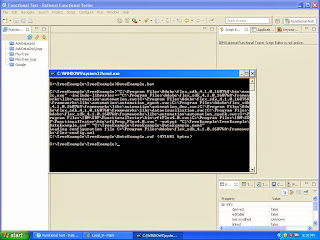I faced some challenges while automating an application, which is partially flex and html, so in this article I'm going to explain how we can test the flex content using IBM Rational Functional Tester 8.5 or above.
Here you go...!!!
Functional Tester supports testing functional aspects of Adobe® Flex
applications. You can record and playback scripts against Flex based user
interfaces inside a Web browser and verify that the application functions
correctly.
Functional Tester supports testing Flex
applications that are built using Flex SDK 2.0.1 or higher. Currently Microsoft® Internet
Explorer version 6.0 ,7.0,8.0,9.0 and 10.0 with the ActiveX Flash Player
version 9.0.28.0 or later supports functional testing on Flex
applications.
Note: Testing Adobe Flex
applications is supported only on 32-bit browsers. Testing Flex applications
on Mozilla Firefox 17.0 browsers is not supported.
|
The testing process is based on the tasks Flex
developers and testers perform. The process for automating functional tests of
Flex applications differs depending on the way developers create the
application-under-test.
Automated testing of Flex applications requires you to load supporting
files. These supporting files can be loaded in two different stages:
- At
compile-time for applications that are enabled for functional testing
- At
run-time for applications that are not enabled for functional testing
Testing Functional
Tester enabled Flex applications
Developers can enable the Flex applications for
testing by compiling the Flex application with Functional Tester agent (rft.swc) and Flex automation framework
libraries (from flex SDK).
Procedure:
You can use either
the IBM Rational Functional Tester Flex user interface or one of the
following tools to enable the Flex application:
Flex Builder :
- Start Flex Builder.
- Create a new Flex project.
- Select the Flex project in the navigator.
- Click Select Project > Properties > Flex
Compiler.
- Type the following argument in the Additional
compiler arguments field: -include-libraries+="C:\Program
Files(x86)\Adobe\flex_sdk_4.1\frameworks\libs\automation\automation.swc;C:\Program
Files (x86)\Adobe\flex_sdk_4.1\frameworks\libs\automation\automation_agent.swc;C:\Program
Files
(x86)\Adobe\flex_sdk_4.1\frameworks\libs\automation\automation_dmv.swc;C:\Program
Files
(x86)\Adobe\flex_sdk_4.1\frameworks\libs\automation\automation_monkey4.x.swc;C:\Program
Files (x86)\Adobe\flex_sdk_4.1\frameworks\libs\datavisualization.swc;C:\Program
Files
(x86)\Adobe\flex_sdk_4.1\frameworks\libs\automation\automation_spark.swc;C:\Program
Files (x86)\IBM\SDP\FunctionalTester\bin\rftFlex4.0.swc;C:\Program Files
(x86)\IBM\SDP\FunctionalTester\bin\rftProp_Flex4.0.swc
(Automation(s) files
are available in flex SDK and Functional
Tester agent (rftFlexX.0.swc) at C:\Program Files
(x86)\IBM\SDP\FunctionalTester\bin)
- Click OK to save your
changes.
- Click OK. The Properties
dialog box closes.
- Compile your Flex application.
After completing above steps create a file- “Flex”
(without extension) in C:\Windows\System32\Macromed\Flash\FlashPlayerTrust
(you may require to create FlashPlayerTrust folder) and provide the path of
your application under test.
- Command-line
compiler :
Compile the Flex application the following command: (DateChooserEvent.bat)
"C:\Program Files
(x86)\Adobe\flex_sdk_4.1\bin\mxmlc.exe"
-include-libraries+="C:\Program Files (x86)\Adobe\flex_sdk_4.1\frameworks\libs\automation\automation.swc;C:\Program
Files
(x86)\Adobe\flex_sdk_4.1\frameworks\libs\automation\automation_agent.swc;C:\Program
Files
(x86)\Adobe\flex_sdk_4.1\frameworks\libs\automation\automation_dmv.swc;C:\Program
Files
(x86)\Adobe\flex_sdk_4.1\frameworks\libs\automation\automation_monkey4.x.swc;C:\Program
Files (x86)\Adobe\flex_sdk_4.1\frameworks\libs\datavisualization.swc;C:\Program
Files
(x86)\Adobe\flex_sdk_4.1\frameworks\libs\automation\automation_spark.swc;C:\Program
Files (x86)\IBM\SDP\FunctionalTester\bin\rftFlex4.0.swc;C:\Program Files
(x86)\IBM\SDP\FunctionalTester\bin\rftProp_Flex4.0.swc" -output
"C:\TestSparkwithRFT\DateChooserEvent.swf"
"C:\TestSparkwithRFT\DateChooserEvent.mxml"
This will result in generation of RFT enabled .swf
file with .html
-------------------------------------------------------------------------------------------
Testing Flex Application using RFT v 8.5
screenshots
Step 1: Configure AUT
with RFT:
Click Add
Step 2: Select kind
of application as flex.
Click Next
Step
3: Select Configure Flex application
setup(if application is running on local host)
Click
Next
Step 4: select local
host, Flex SDK version. Also provide .mxml file(if application is running using
tomcat, please provide .mxml file C:\Program Files (x86)\Apache Software
Foundation\Tomcat 7.0\webapps\Sample\<index.mxml>), Also provide location
to keep .swf file (usually that will be same.
This will generate .bat
file and .html files. (You may require editing .bat file with correct FLEX
Automation Libraries path as mention in command-line compiler. Refer fig 8)
Step 5:
Click Finish.
Step 6: Click Apply
and run to check whether application is running in browser or not.
Command
Line compilation:
Step 7: Copy the path
of AUT containing .html file( where the application is deployed) to C:\Windows\System32\Macromed\Flash\FlashPlayerTrust>
flex file. (create a Flex file
without extension)
Step 8: Paste the
path in Flex file.
Step 9: Again
configure application under test using RFT:
·
Click Add
·
Select Flex
·
Click on Add URL of Flex application and provide
the path of application.
Ex: C:\TestSparkwithRFT\AdvDataGrid\AdvancedDataGridExample.html
Step 10: Click finish.
1. Creating a New
Project:
2. Give script name.
3. Start recording test.
Example:
-------------------------------------------------------------------------------------------------------
How to Enable IE, Mozilla with RFT
Open Control Panel> JAVA>Advance> disable
Java next generation plugin.
Use only one JAVA at a time.
In JAVA control Panel, Click Java Tab and select
only one JAVA(both for user and system)
To Enable IE, you may
require to register RTXIEEnabler.dll
1.
Open command-prompt.
2.
Navigate to \IBM\SDP\functional
Tester\bin
3.
Type regsvr32 RTXIEEnabler.dll
Also you can use processexplorer tool to check,
whether RTXIEEnabler.dll file is running or not.
Flex Objects are not getting recognized
by IE, Mozilla:
1.
Open command-prompt.
2.
Navigate to \IBM\SDP\functional
Tester\bin
3.
Type regsvr32 RFTFlexPlugin.dll
4.
Type regsvr32 RFTFlexPluginPS.dll
References:



























